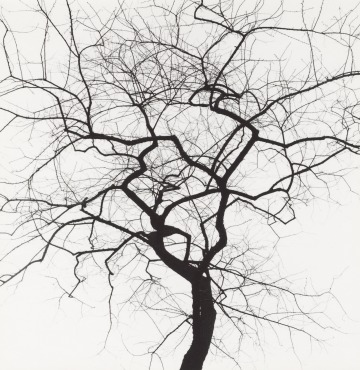How Trees Tell Stories
Photography as art and science
Ansel Adams’ redwoods almost steal the show at the University of Arizona Center for Creative Photography’s most recent exhibition, “Trees Stir in Their Leaves.” But they have plenty of competition in the powerful exhibit focusing on science, art and trees running through July 23.
With more than 75 images and other objects, it fills the CCP’s new space — the Alice Chaiten Baker Interdisciplinary Gallery, located off the center’s main lobby.
The show focuses on how we can learn from trees — some so ancient, they were alive when the pyramids were built in Egypt.

George A. Tice Tree #14, New York, 1965 Gelatin silver print 11.3 x 11.1 cm Center for Creative Photography, University of Arizona: Gift of the artist © George A. Tice
“To find the wealth of information trees have to share, we must simply learn how to look,” says Valerie Trouet, a professor in the UArizona Laboratory of Tree-Ring Research (LTRR), which is a partner in the event. Her book about dendrochronology, or the study of tree rings, is called “Tree Story.” Published in 2020, it is now in paperback.
The exhibit reveals for the first time the laboratory’s own photo collection from a century of work across the globe, documenting how to learn from the interior patterns called tree rings.
It was a delight for CCP co-curator, Meg Jackson Fox, to discover that the LTRR had photo treasures of its own. “We looked at hundreds of their images,” she says. Twenty-one images — depicting species from sequoias to Chilean cedars — landed in the show. Some were digitized from old Kodachrome slides, lantern slides or postcards from the 1930s.
A third event partner is the UArizona Arboretum, which offers a complementary self-guided tree tour with 15 stops on campus to examine trees and their cousins. It’s called Photo Walks Around the World and includes three “walks” focusing on species from different geographic regions: the Southwestern U.S., South America and the Mediterranean. Printable guides are available via links on the Arboretum’s website.
The walking tour begins near CCP with the medicinal Mexican fencepost cactus. Along the tour, you’ll meet a cork oak, a queen palm and the palo borracho (or “drunken stick”), lovely despite its odd name.
The Arboretum’s director, Tanya Quist, explains, “The experience for participants aims to renew their spirits through beauty, enlighten their minds through science and deepen their love of the university through the campus living collections.”
The walks were created in response to the interdisciplinary exhibit by CCP and LTRR, Quist says, “as a way to physically connect the two facilities on opposite sides of campus.”
Back at the CCP, three examples illustrate the scope of the show:
A twisted apple tree photographed in Chernobyl starkly recalls the damage from the nuclear disaster there in 1986 and reminds viewers that not all the victims were human.
A slice of wood tells the saddest of all tree stories: It was part of the Prometheus, a bristlecone pine in Nevada that was nearly 5,000 years old when it was inadvertently cut down about 70 years ago. It was the oldest tree ever dated, and this cross section helps tell the story of dendrochronology.
And a stunning image of an Emory oak tree in rural Arizona, photographed by Barbara Bosworth in 2001 as it spread its limbs wide to shade a space seemingly as big as a tennis court, invites viewers to reflect on the relationships between people and landscapes.
The science side of the show offers a rare glimpse of a century-old analog computer, made by astronomer and LTRR founder A. E. Douglass in 1913. The device — about 16 feet long, with chains, gears, lenses and mirrors — linked up solar cycles with tree rings to test his theories that sun events might affect climate.
“And this is how the science of tree rings was born, here at the University of Arizona,” comments Charlotte Pearson, of the LTRR faculty. “He was right.”
Visits to the three branches of this event — the exhibit at the CCP, the Arboretum’s walking tour and the LTRR, which recently resumed its public tours — offer in-depth looks at Arizona science and arts.
“It’s the first time to bring into conversation the collections of three University gems, and our communities will have the opportunity to experience a unique layering of trees, through science and art and the stories between the them,” says Jackson Fox.
Charlotte Pearson of LTRR adds, “It’s a celebration of the arts and sciences and the power of these two combined approaches.”
